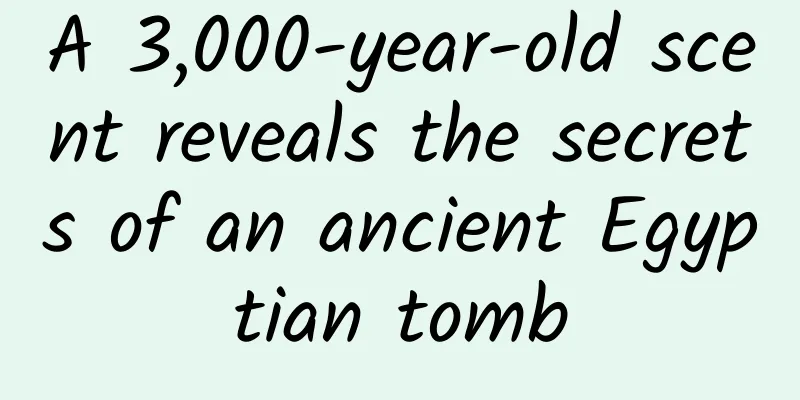A 3,000-year-old scent reveals the secrets of an ancient Egyptian tomb

|
More than 3,400 years ago, two ancient Egyptians were buried. Today, the food jars left behind to nourish their eternal souls still emit aromas. A team of analytical chemists and archaeologists analyzed the odors to help identify the jars' contents. The research shows how "smell archaeology" can enrich our understanding of the past—and perhaps make museum visitors more immersive. The discovery of the intact tomb of Kha and Merit in the necropolis of the Village of Craftsmen in Medina, near Luxor, in 1906 was a landmark moment in Egyptology. The tomb of Kha (who was the "superintendent of works," or architect) and his wife Merit remains the most complete non-royal ancient tomb ever found in Egypt. It provides important information about how the upper class were treated after death. “The collection is quite amazing,” says Ilaria Degano, an analytical chemist at the University of Pisa in Italy. “There are even pieces of Kha’s ancient Egyptian linen underwear with his name embroidered on them.” Contrary to common practice at the time, even after the items were transferred to the Egyptian Museum in Turin, Italy, the archaeologists who discovered the tomb resisted the temptation to "unseal" the mummy or peer inside the sealed amphorae and other jars. The contents of many of the containers remain a mystery, but Degano said there are some clues. "From conversations with museum staff, we learned that there was some fruity aroma that could be smelled in the display case," she said. Odor analysis Degano and his colleagues placed various artifacts—including sealed jars and open cups filled with the remains of decaying ancient food—in plastic bags for several days to collect some of the volatile molecules they were still releasing. The team then used a mass spectrometer to identify the scent components in each sample. They found aldehydes and long-chain hydrocarbons that indicate the presence of beeswax, trimethylamine associated with dried fish, and other aldehydes commonly found in fruit. “We found it in two-thirds of the objects, which was a big surprise,” Degano says. The findings will be part of a larger research project that will reanalyze the tomb's contents and paint a more complete picture of non-royal burial customs at the time when Kha and Merit died, about 70 years before Tutankhamun ascended the throne. This isn’t the first time that scent components have revealed important information about ancient Egypt. In 2014, researchers extracted volatile molecules from 6,300-5,000-year-old linen bindings that wrapped some of the earliest known bodies in Egyptian cemeteries. These molecules confirmed the presence of preservatives with antimicrobial properties, suggesting that Egyptians began experimenting with mummification about 1,500 years earlier than previously thought. According to Stephen Buckley, an archaeologist and analytical chemist at the University of York in the United Kingdom who was involved in the 2014 study, smell analysis is an under-explored area of archaeology. “Archaeologists have ignored volatiles because they assumed they were lost from artifacts,” he said. “But if you want to understand the ancient Egyptians, you want to delve into the world of smell.” For example, for the ancient Egyptians, incense obtained from fragrant resins was a necessity. "Incense was essential in temple ceremonies and some funeral ceremonies," said Kathryn Bard, an archaeologist at Boston University in the United States. Because there were no resin-producing trees growing in Egypt, the ancient Egyptians had to travel long distances to obtain these supplies. Add color and fragrance In addition to improving our understanding of ancient civilizations, ancient smells may also add a new dimension to the museum experience. "Smell is a rarely-visited portal into our collective history," says Cecilia Bembibre of University College London. "It allows us to experience the past in a more emotional and personal way." But Bembibre also said that reconstructing smells from ancient times is not easy. Degradation and decomposition can produce odors, so the smell obtained from an artifact today may not match what Bembibre calls the original "smell landscape" of the tomb. Buckley believes that with the right knowledge and understanding, it is possible to separate the original smell from the smell of decomposition. As for whether visitors really want to fully experience the potentially unpleasant smellscape of the ancient tomb, it is still a topic for discussion. "The curators may want people to choose how much of the olfactory experience they want to get." Buckley said. |
<<: The most "curly" ginkgo pest in nature: the super small leaf roller
Recommend
Why can I still eat dessert when I am already full? Do I really have another stomach?
Image source: Unsplash When you have just finishe...
Youzi Xiaobai's money-making project, earning 500+ Douyin mini program every day without any foundation
10-25 [New Course] Video account operation book l...
APP promotion: Ten methods used by experts to attract traffic, how many of them do you know?
There are a lot of them, so be patient and choose...
Why do people drink ice beer when eating crayfish, but no one drinks ice liquor?
After a week of hard work, how do you plan to tre...
Jia Zhen's "Xiaohongshu Merchant Camp" Issue 6 Merchant Edition, let merchants lose paid traffic
Course Contents: 【Xiaohongshu Merchant Camp】The 6...
Tips for creating popular articles on Baijiahao, teaching you how to create popular articles on Baijiahao?
Today I will give you some of my humble opinions ...
Domestic brands will reduce prices and enter the first echelon in the future to survive
From the 1 billion yuan red envelope subsidy camp...
Experts suggest: Eat only 70% full for dinner! How full is "70% full"?
Expert of this article: Pa Lize, Chief Physician ...
Earphones may make Apple the king of wearables
I ran down the subway station stairs, thinking I ...
PS4 version of "Berserk Warriors" review: the most fierce warrior classic scene in history is perfectly reproduced
Speaking of "Berserk", comic fans who a...
4 ways to promote brand marketing in the education industry
According to statistics from the China Internet N...
Mr. Crab · Short video traffic-the gameplay of the picture and text account is super simple, can be copied and matrixed, and is worth 1888 yuan
Mr. Crab · Short video traffic diversion - The ga...
Strong winds and sandstorms will hit tomorrow! How to avoid "eating dirt"?
Yesterday, snowfall occurred in Qinghai, Heilongj...
Android 5.0: Root's super nightmare!
After the second preview of Android 5.0 was relea...
1,000 km range and super fast charging become a reality, GAC Aion expects to double its production capacity next year
If you ask which domestic new energy vehicle bran...









